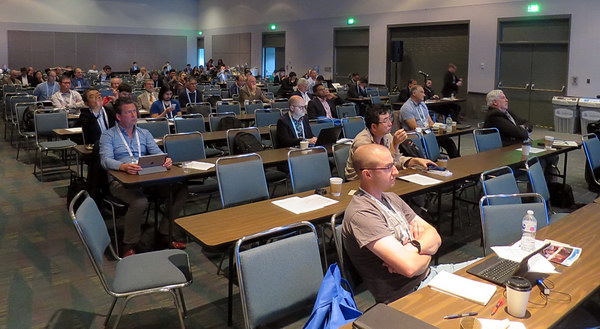 The audience was somewhat sparse at the Immersive Experience Conference (Credit: M. Brennesholtz)
The audience was somewhat sparse at the Immersive Experience Conference (Credit: M. Brennesholtz)
On Wednesday of Display Week I attended the Immersive Experience Market Focus Conference, an all-day event. The conference covered, well, immersive experiences both on the large screen such as CAVE and Dome systems and on small screen VR HMD immersion. About half of the material presented was related to VR HMDs, a quarter was related to large screens and the remainder was mostly content-creation, software, historical issues and blue-sky stuff that could relate to either large or small immersive images. Unfortunately, the conference was a discordant collection of speakers. Most speakers taken alone did a good job but the mixture of speakers did not lead to a conference that provided a coherent message to its attendees. While I personally found some of the hard technology talks interesting, such as the one from Schott about RealView glass for AR HMDs or Adrian Travis’s talk on steered-pupil AR systems interesting, the “senior executives, technical managers and marketing personnel from leading companies” that were the target audience for the conference would have found them less valuable.
The short discussion of most of the speakers presentations at the conference are given below in the order they were presented. As can be seen, the speakers probably could have been grouped in a more useful order.
Session 1: Market Status
Unfortunately, I missed the presentation on the market status of immersive displays from Barry Young, CEO and President of the OLED Association who was also the host of the conference. I’m not sure why they couldn’t find a person more directly connected with the immersive industry to give the talk, however. (The originally planned moderator – Mark Fihn was not able to attend because of a late health issue – Man. Ed.)
 Good storytelling trumps technology issues when it comes to storytelling. (Credit: P. Ludé, Immersive Experience Conference. (IEC))
Good storytelling trumps technology issues when it comes to storytelling. (Credit: P. Ludé, Immersive Experience Conference. (IEC))
One of the first speakers was Peter Ludé, now CTO of Mission Rock Digital. He discussed the use of immersive experiences both on the large or small screen to tell stories. He discussed much of this in terms of the phrase “willing suspension of belief,” a critical issue for any storyteller. He discussed the various immersive technologies that aid in the suspension of belief. In the end, he added one caveat: good storytelling trumps all the technological features. If you don’t have a good story or you don’t tell your story well, all the immersive experience in the world goes to waste.
Session 2: Goggles and Glasses
I discussed Adrian Travis’s discussion steered pupil AR HMDs along with his SID paper on a similar topic elsewhere in this special report, so I won’t repeat it here. (NEDs with Eye Focus Cues at Display Week – Roundup)
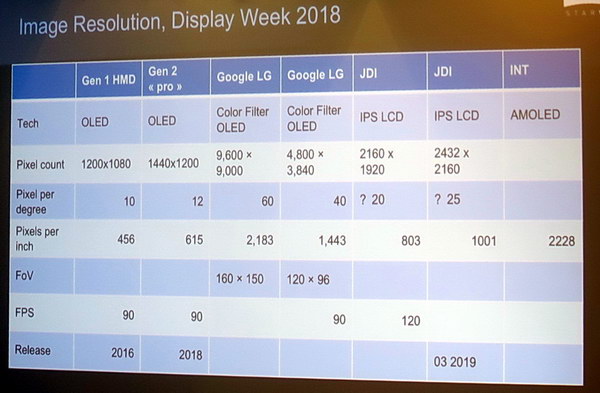 Bernard Mendiburu’s summary of VR HMDs (Credit B. Mendiburu at the IEC)
Bernard Mendiburu’s summary of VR HMDs (Credit B. Mendiburu at the IEC)
Bernard Mendiburu, director of Cinematic VR Technologies at Starbreeze Studios gave the second talk in the session. It was a very good summary of the human factors associated with VR HMDs, with special emphasis on resolution and field of view.
Dave Chavez, CTO of zSpace gave the next talk. His basic premise was that people have two eyes for a reason – to see everything in 3D. Things seen only in 2D, i.e. almost everything shown on a display in the world including the screen his presentation was on and the computer monitor where I’m writing this article, were unnatural. And, of course, zSpace has a solution to that.
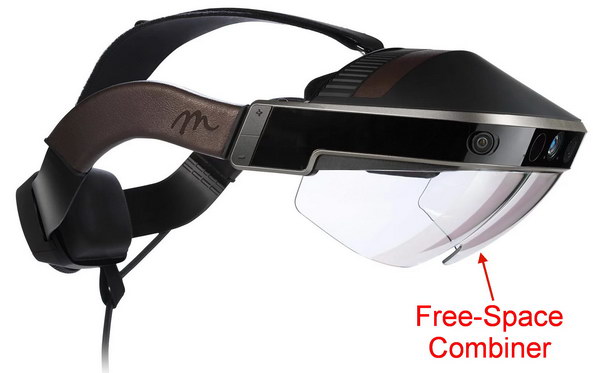 The free-space see-through combiner on a Meta VR HMD (Credit: Meta)
The free-space see-through combiner on a Meta VR HMD (Credit: Meta)
Kari Pulli, CTO of Meta, provided the keynote speech for this session. His talk was titled “Immersive Optical-See-Through AR with Meta-2.” He gave a review of the history of see-through AR HMDs from the Sony Glasstron, first released in 1996, through the first Meta prototype in 2012 to the Meta 2, released in 2017. Since the Meta 2 is relatively large, he emphasized how Meta had studied the human head and optimized the Meta 2 to make it comfortable to wear despite its size. Since the Meta 2 uses a free space combiner for its see-through AR system, rather than the conventional waveguide combiner, it was an interesting talk. There were no talks on free-space combiners in the technical sessions at SID.
Session 3: Direct View Displays
The first talk in session 3 was by Maarten Tobias, CEO of Dimenco. He talked on the newly introduced Dimenco technology platform called “Simulated Reality.” Since this introduction happened at SID the day before, it is covered elsewhere in this special issue.
 The SunCAVE at the UCSD. (Credit: J. Polizzi, IEC)
The SunCAVE at the UCSD. (Credit: J. Polizzi, IEC)
The next talk at the IEC was by Joel Polizzi from the University of California at San Diego and was titled, “Digging into a Digital Cave: Scientific Exploration and Innovation in the SunCAVE.” In addition, he talked about other partially immersive display systems at the UCSD and the multi-node computer system to drive them. Since the SunCAVE and the other units he discussed were made from tiled LCD panels and the mullions were very clearly visible, it is hard to imagine them as fully immersive.
 US 2,955,156, “Stereoscopic Television Apparatus for Individual Use” from 1957
US 2,955,156, “Stereoscopic Television Apparatus for Individual Use” from 1957
The last talk of the morning was given by Lenny Lipton, who is always entertaining to listen to. His talk was titled “The Paradox of VR: Big vs Small.” He discussed the history of immersive experiences. His discussion of large displays started with the Panorama from Barker in 1797. This was a large building with a painting that encircled the audience who stood at the center. These immersive experiences, often depicting battle scenes, were popular through the 18th and 19th century when they were displaced by the movies. Ordinary movies were in turn displaced by increasingly immersive systems, including color, Cinerama, Cinemascope, dome projection and CAVEs. Small near-eye displays started with peepshows in the mid-17th century and included the stereoscope in 1849, the Kinetoscope in 1891, the first VR HMD in 1957, Sensorama in 1961 through modern VR HMDs. It was an interesting talk if you like technology history, which I do.
Session 4:Virtual Displays
The first talk of the afternoon was from Ruediger Sprengard, VP of Augmented Reality at Schott. He talked about Schott’s newly introduced RealView glass specifically designed for see-through AR light guides. This product introduction is covered elsewhere in this special report.
The next talk was from Edward Tang, Co-Founder and CEO of Avegant, and was titled “Enabling Mixed Reality: Lightfield and other challenges.” I guess it was an OK talk but by then I’d seen too many introductions to VR to be really interested.
After him came Jon Karafin, co-founder and CEO of Lightfield Lab. He would have been a boon companion to Dave Chavez of zSpace, although while Chavez believed everything should be 3D, Karafin seemed to believe everything should be light field 3D. Dave Fattal, the next speaker and Founder & CEO of Lei, could have joined Jon and Dave for a beer after the conference. At least Fattal gave a coherent explanation of how light field displays work and differ from conventional displays.
The keynote speaker for session 4 was Paul Debevec, Sr. Scientist at Google VR. He discussed how light field displays, cameras and lighting techniques, along with AI, contributed to some of the special effects in the current cinema.
Session 5: Next Generation Magic
The featured speaker in this session was Andrew Cochrane, a freelance VR/AR/interactive content creator. He gave a surprisingly reasonable and useful talk on market predictions for VR and AR. Many people have been disappointed that VR and AR have not grown at the rates forecast for them just a year or so ago. According to some of the more extreme of these forecasts, we should all be wearing AR HMDs today. He said these forecasts were often based on the very rapid uptake of a few technologies, especially the smartphone. He said mobile communication devices including smartphones have a much longer history than most people realize. Mobile personal communications started in 1918 in Germany using surplus equipment from The Great War and had many years of slow growth before the explosion of smartphones.
He added that smartphones cannibalized an existing market for cell phones and VR/AR has no similar existing market to cannibalize. The uptake of mobile phones, which took nearly 100 years to reach near-100% saturation, is a better model for the growth of AR and VR than smartphones themselves. He gave other examples of the uptake of technologies that were slower than modern forecasters realize, including the cinema, the Internet and video games. Then he gave evidence that there has, in fact, been an uptake of AR and VR technology and it is too early to give up on these markets. The uptake has just been slower than enthusiasts expected but has not been ‘slow’ in an absolute sense, not compared to other communications technologies.
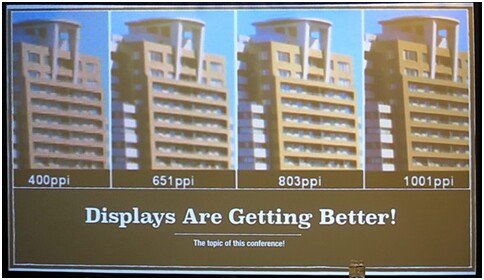 Andrew Cochrane said he knew this slide was obsolete as soon as he arrived at Display Week where he saw 2000ppi displays. In fact, displays up to 4000ppi were discussed at SID. (Credit: Andrew Cochrane)
Andrew Cochrane said he knew this slide was obsolete as soon as he arrived at Display Week where he saw 2000ppi displays. In fact, displays up to 4000ppi were discussed at SID. (Credit: Andrew Cochrane)
Cochrane didn’t make any specific numerical predictions for VR and AR, something that I think of as wise, given the uncertainty in the market. Instead, he concluded his presentation with a series of slides showing how various aspects of VR and AR were improving better than the pessimists were expecting but, of course, not as fast as most of the optimists had forecast. Each of his concluding slides made a different point about advances in VR, advances that are perhaps not noticed by many of the people examining the VR market. Each slide included a photo showing some aspect of that advance, such as the display slide shown above.
- We ARE making progress.
- At a surprisingly fast pace, if you apply the right expectations.
- VR Videogames are working
- If budgeted appropriately
- LBE [Location-based entertainment] is starting to work
- The most promising form of VR
- 360° is getting better
- Distribution to headsets is still lacking
- 180° is promising
- “Immersive enough”
- Domes are ascending
- Multi-user immersive content is going to be hot
- Reality capture is getting good
- LiDAR, Photogrammetry and HDRI – Oh My!
- Lightfields are promising
- Google is leading the charge
- Volumetric video is promising
- Rendering is evolving
- New ways to render 3D imagery are coming to market
- Displays are getting better!
- The topic of this conference!
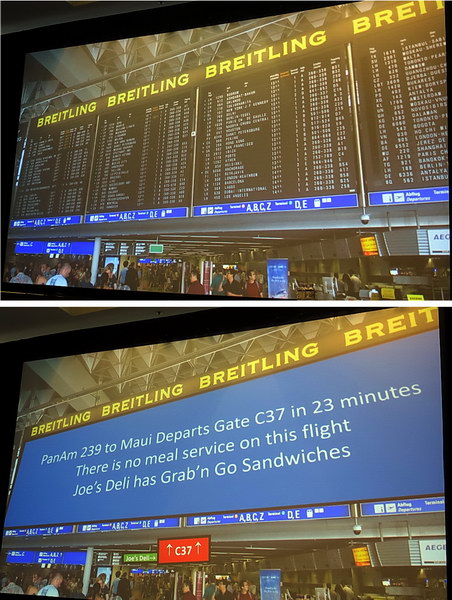 Top: What a airport visitor sees when visiting an airport today. Bottom: What the same visitor might see if the airport used a Parallel Reality sign from Misapplied Sciences. (Credit: P. Dietz, IEC)
Top: What a airport visitor sees when visiting an airport today. Bottom: What the same visitor might see if the airport used a Parallel Reality sign from Misapplied Sciences. (Credit: P. Dietz, IEC)
Paul Dietz, CTO and Chairman of the Board of Misapplied Sciences talked about his company’s technology that he calls “parallel reality displays.” This technology would allow different people, even ones standing adjacent to each other in a crowd, to see different images on a digital sign. I’ve seen this technology proposed before from a different company and it is, at least theoretically, a feasible technology. He envisions, for example, the departure board in an airport terminal not showing all departing flights, flight times and gates. Instead, each person in the terminal would see only his flight along with instructions on how to get to that gate. To implement this sort of system, however, you need to know not only exactly where everyone in the terminal is, but what flight each person within viewing range of a signboard will take. Even Dietz admits that this raises privacy issues.
Two speakers in session five, Damien Lichtenstein, Founder and CEO of Futurism Entertainment, and the closing speaker, Michael Ludden, Director of the IBM Watson Developer Labs & AR/VR Labs, merge together in both my mind and my notes. It took me a while to realize the Watson the IBM man, Ludden, was talking about was IBM’s AI software, not IBM’s Thomas J. Watson Research Center. The two speakers can both be summarized by saying we have a bright, beautiful future and we should be happy the future will have lots of AR, VR and AI. –Matthew Brennesholtz

